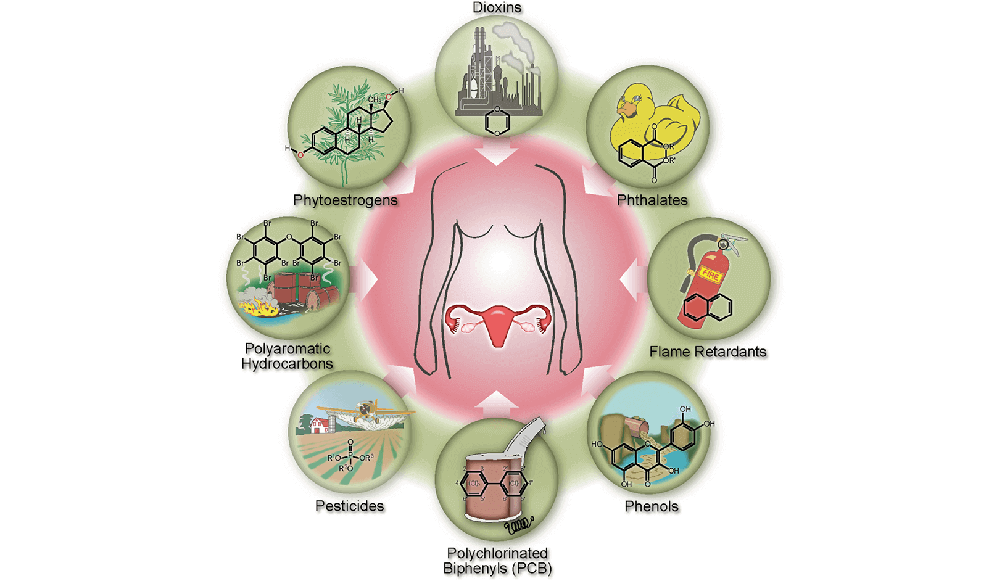Endocrine Disruptors Are Everywhere
There are many chemicals in the environment that affect our bodies, and especially our hormones. These are found in the air, soil, water supply, food and personal care products, and interfere with your body’s natural hormones. They are called Endocrine disruptors.
They are found in everyday products, such as, plastics, food cans, detergents, flame retardants, food, toys, cosmetics, and pesticides. According to Environment Health News, these chemicals affect developmental, reproductive, brain, and immune-system functions. Even low doses of EDCs may be unsafe. Even low doses of endocrine-disrupting chemicals (EDCs) may be unsafe.
“Endocrine disruptors (EDs) either act like or block your natural hormones.”
For the past 20 years, EDCs appear to have been responsible for the growing number of people with infertility, diabetes, early onset of puberty in girls and early menopause in women, cancer, birth defects, and neurobehavioral disorders,”
(www.hormone.org).
“It’s an easy yet powerful fix to eliminate chemicals in your home and personal products,” says Topanga resident, Jane Hammond, a physician assistant specializing in hormone replacement therapy. “Start by simply eliminating all scented personal and laundry products. Even small changes can help.”
EDCS TO LOOK FOR AND AVOID
Here are names to look for on EDCs that exist in almost everything we use in our daily lives:
• Bisphenol A (BPA) - Found in many plastic products including food storage containers
• Dioxins - from chemical and pesticide manufacturing, waste burning, and wildfires
• Perchlorate - a by-product of rocket fuels. Used as propellants and on food packaging.
• Perfluoroalkyl and Polyfluoroalkyl Substances (PFAS) - used widely in coating on non-stick pans, paper, and textiles.
• Phthalates - used in plastics, found in food packaging, cosmetics, and medical supplies,
• Phytoestrogens (plant hormones) - naturally occurring substances in plants that have hormone-like activity. Found in soy products like tofu or soy milk
• Polybrominated diphenyl ethers (PBDE) - found in flame retardants for furniture, foam and carpets
• Polychlorinated biphenyls (PCB) - used to make electrical equipment like transformers, hydraulic fluids, lubricants, and plasticizers
• Triclosan - may be found in anti-bacterial soaps
HOW TO AVOID EXPOSURE IN THE HOME
• Avoid BPA- Use stainless steel or glass water bottles.
• Eliminate all scented products including soaps, air fresheners, scented candles, cleaning products, dryer sheets, fabric softeners, and perfumes.
• Avoid harmful volatile organic compounds (VOCs) like gasoline, oil, solvents, and dry cleaning fluids that are linked to asthma and some cancers
• Avoid chemical cleaning products
• Avoid canned foods with BPA liners, choose fresh or frozen
• Avoid handling register receipts, the paper has a high concentration of EDs
• NEVER EVER MICROWAVE IN PLASTIC!
ALTERNATIVES FOR THE HOME
• Use wool dryer balls instead of fabric softener or dryer sheets in the dryer.
• Avoid scented laundry products. They leave chemicals in your clothes that are absorbed through the skin. They also pollute the air.
• Use home-made vinegar cleaning products.
• Create your own all-purpose cleaning solution. The simplest one is: combine a mixture of half vinegar to half water in a spray bottle, and add 10 drops of essential oil. More DIY cleaning recipes at drpompa.com.
“These small changes are subtle but they will impact your health and the health of the planet in a big way,” Hammond says.
RESOURCES:
The Environmental Working Group has an app that can be downloaded on your phone and is a great place to look up more ways to limit exposure to hormone disruptors in your home. (www.ewg.org). â–








